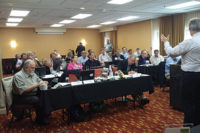The future of grease interceptors lies in South Florida.
Recently, the Sunshine State’s most highest-populated county imposed a 99% efficiency requirement for all grease interceptors installed within its borders.
Rachel Beaulieu, a product manager with Barrie, Ontario, Canada-headquartered Endura Grease Management, expects more growth as other regions that have issues with FOG will be tasked by the U.S. Environmental Protection Agency to increase efficiency standards, such as Miami-Dade County.
“(That was a) number previously thought unattainable,” she notes. “We anticipate the regulations surrounding FOG management will only become stricter as the technology for grease interception continues to not only answer the call of higher performance, but continue to raise the bar.”
Kevin Wong, the Canadian national specifications manager with Chicago, Illinois-based manufacturer MIFAB, believes the ordinance made in Miami-Dade will shift the market away from concrete interceptors.
“We will see more metal and nonmetal units being installed depending on the conditions and location within or outside the building,” he says.
Beaulieu notes the regulatory landscape for FOG management around the U.S. is complex. Endura has advanced its range of applications with adjustments to smaller products, she states. She adds the company also has new products coming later this summer.
“The dynamic inlet baffle in our Endura XL series and (our) maintenance calculator is hitting the market later this summer. Also, there will be smaller design tweaks such as improved fastening systems and lid rating offerings,” she says.
MIFAB recently introduced its SuperMax II HPDE large-scale interceptor to the marketplace. Wong believes the units have a flexibility in the field that hasn’t been available before.
“HPDE is a proven wasterwater material,” he states. “In addition, the use of generic corrugated pipe extensions makes the units easy to bury in the field to the depths compliant to the job vs. what’s specified on paper.”
Beaulieu adds North America’s regional plumbing code differences have slowed the country’s adoption of its large-capacity hydromechanical grease interceptors. Still, the company, Beaulieu notes, continues to be “actively engaged” in work with ASME, CSA, PDI and other industry organizations and committees.
“Our products’ acceptance is widespread, but not all encompassing,” she says. “Most recently, we’ve contributed to the development of ASME A112.14.3 – 2018, the newly revamped ASME standard for hydromechanical grease interceptors.”
To view a video of MIFAB President Michael Whiteside from the Winsupply 2018 Strategic Planning Meetings and Vendor Showcase, see here.
This article was originally titled “FOG market ready to heat up” in the June 2018 print edition of PM Engineer.





